HA3042 Taxation Law Assignment: FBT and CGT Issues and Solutions
VerifiedAdded on 2022/11/24
|10
|2071
|436
Homework Assignment
AI Summary
This assignment solution addresses two key areas of Australian taxation law: Fringe Benefits Tax (FBT) and Capital Gains Tax (CGT). The first part focuses on FBT, specifically the computation of FBT liability for Spiceco Pty Ltd, analyzing different FBT computation methods (statutory and operating cost methods) and recommending the most appropriate method based on minimizing tax liability. The second part delves into CGT, calculating the net capital gain or loss for Daniel Ray, considering various CGT events, including the sale of a main residence, collectibles, shares, and the implications of loans and interest expenses. The solution applies relevant sections of the FBTAA 1986 and ITAA 1997, demonstrating an understanding of tax law concepts and principles, and providing detailed calculations and analysis to support the conclusions.
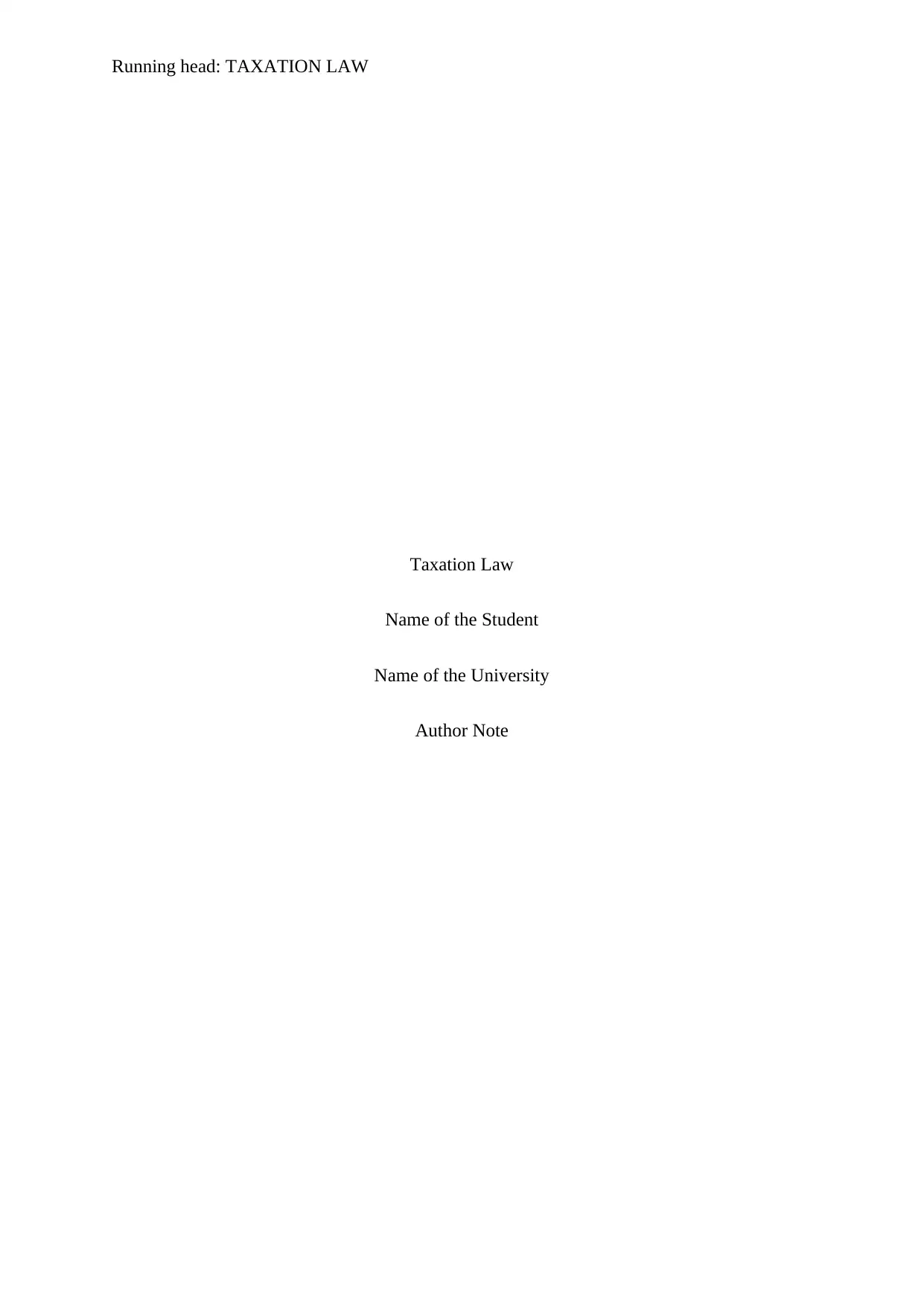
Running head: TAXATION LAW
Taxation Law
Name of the Student
Name of the University
Author Note
Taxation Law
Name of the Student
Name of the University
Author Note
Paraphrase This Document
Need a fresh take? Get an instant paraphrase of this document with our AI Paraphraser
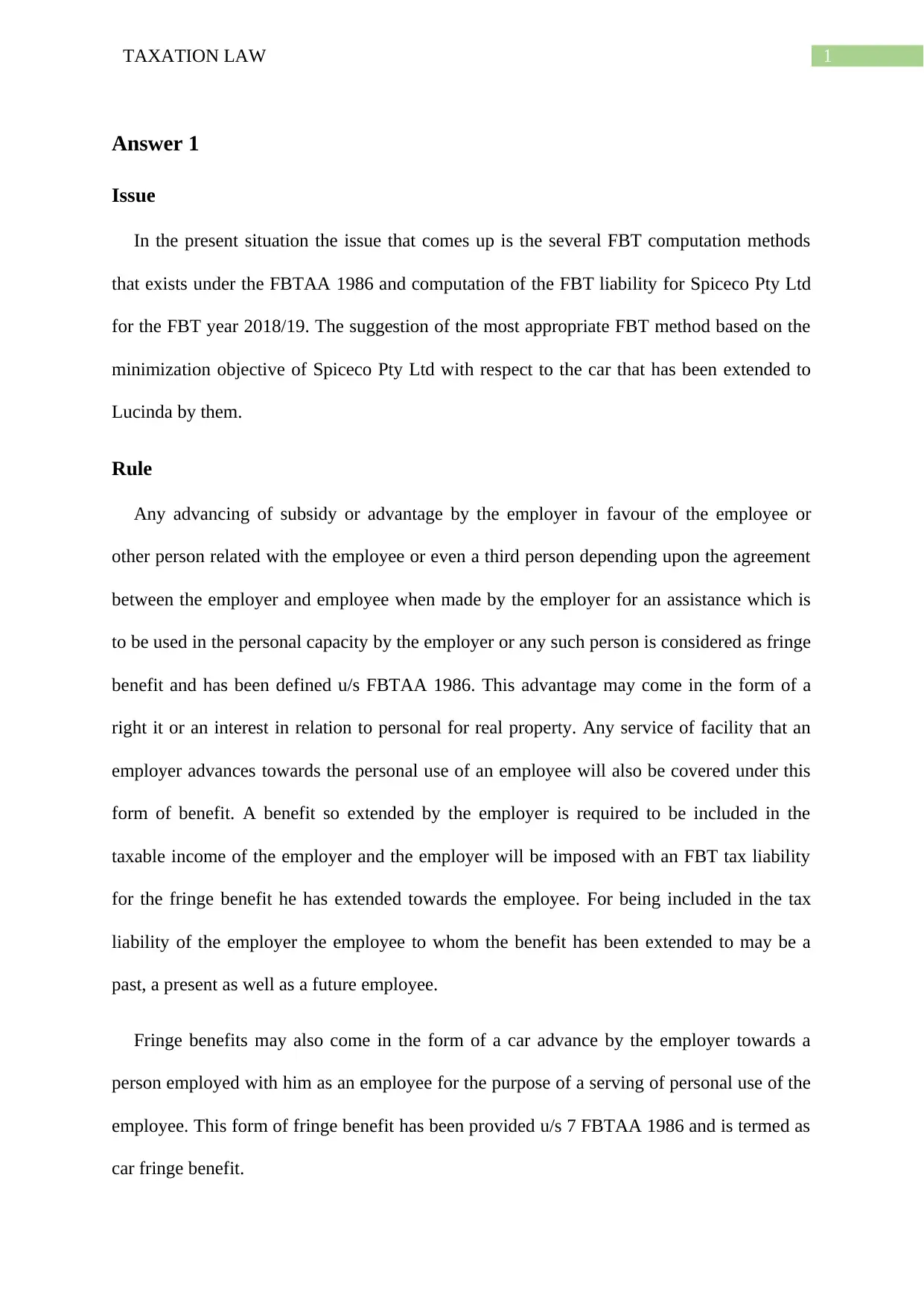
1TAXATION LAW
Answer 1
Issue
In the present situation the issue that comes up is the several FBT computation methods
that exists under the FBTAA 1986 and computation of the FBT liability for Spiceco Pty Ltd
for the FBT year 2018/19. The suggestion of the most appropriate FBT method based on the
minimization objective of Spiceco Pty Ltd with respect to the car that has been extended to
Lucinda by them.
Rule
Any advancing of subsidy or advantage by the employer in favour of the employee or
other person related with the employee or even a third person depending upon the agreement
between the employer and employee when made by the employer for an assistance which is
to be used in the personal capacity by the employer or any such person is considered as fringe
benefit and has been defined u/s FBTAA 1986. This advantage may come in the form of a
right it or an interest in relation to personal for real property. Any service of facility that an
employer advances towards the personal use of an employee will also be covered under this
form of benefit. A benefit so extended by the employer is required to be included in the
taxable income of the employer and the employer will be imposed with an FBT tax liability
for the fringe benefit he has extended towards the employee. For being included in the tax
liability of the employer the employee to whom the benefit has been extended to may be a
past, a present as well as a future employee.
Fringe benefits may also come in the form of a car advance by the employer towards a
person employed with him as an employee for the purpose of a serving of personal use of the
employee. This form of fringe benefit has been provided u/s 7 FBTAA 1986 and is termed as
car fringe benefit.
Answer 1
Issue
In the present situation the issue that comes up is the several FBT computation methods
that exists under the FBTAA 1986 and computation of the FBT liability for Spiceco Pty Ltd
for the FBT year 2018/19. The suggestion of the most appropriate FBT method based on the
minimization objective of Spiceco Pty Ltd with respect to the car that has been extended to
Lucinda by them.
Rule
Any advancing of subsidy or advantage by the employer in favour of the employee or
other person related with the employee or even a third person depending upon the agreement
between the employer and employee when made by the employer for an assistance which is
to be used in the personal capacity by the employer or any such person is considered as fringe
benefit and has been defined u/s FBTAA 1986. This advantage may come in the form of a
right it or an interest in relation to personal for real property. Any service of facility that an
employer advances towards the personal use of an employee will also be covered under this
form of benefit. A benefit so extended by the employer is required to be included in the
taxable income of the employer and the employer will be imposed with an FBT tax liability
for the fringe benefit he has extended towards the employee. For being included in the tax
liability of the employer the employee to whom the benefit has been extended to may be a
past, a present as well as a future employee.
Fringe benefits may also come in the form of a car advance by the employer towards a
person employed with him as an employee for the purpose of a serving of personal use of the
employee. This form of fringe benefit has been provided u/s 7 FBTAA 1986 and is termed as
car fringe benefit.
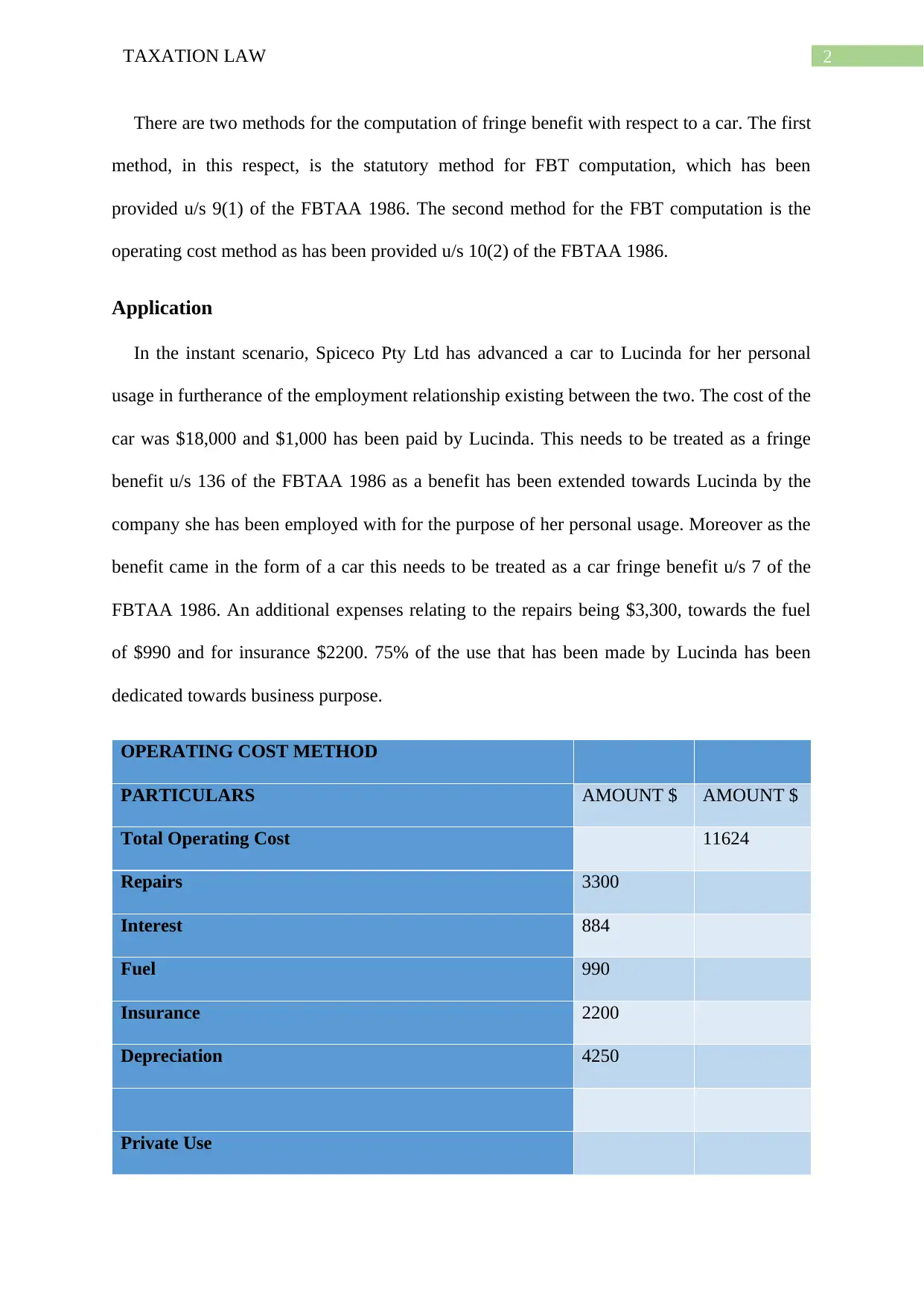
2TAXATION LAW
There are two methods for the computation of fringe benefit with respect to a car. The first
method, in this respect, is the statutory method for FBT computation, which has been
provided u/s 9(1) of the FBTAA 1986. The second method for the FBT computation is the
operating cost method as has been provided u/s 10(2) of the FBTAA 1986.
Application
In the instant scenario, Spiceco Pty Ltd has advanced a car to Lucinda for her personal
usage in furtherance of the employment relationship existing between the two. The cost of the
car was $18,000 and $1,000 has been paid by Lucinda. This needs to be treated as a fringe
benefit u/s 136 of the FBTAA 1986 as a benefit has been extended towards Lucinda by the
company she has been employed with for the purpose of her personal usage. Moreover as the
benefit came in the form of a car this needs to be treated as a car fringe benefit u/s 7 of the
FBTAA 1986. An additional expenses relating to the repairs being $3,300, towards the fuel
of $990 and for insurance $2200. 75% of the use that has been made by Lucinda has been
dedicated towards business purpose.
OPERATING COST METHOD
PARTICULARS AMOUNT $ AMOUNT $
Total Operating Cost 11624
Repairs 3300
Interest 884
Fuel 990
Insurance 2200
Depreciation 4250
Private Use
There are two methods for the computation of fringe benefit with respect to a car. The first
method, in this respect, is the statutory method for FBT computation, which has been
provided u/s 9(1) of the FBTAA 1986. The second method for the FBT computation is the
operating cost method as has been provided u/s 10(2) of the FBTAA 1986.
Application
In the instant scenario, Spiceco Pty Ltd has advanced a car to Lucinda for her personal
usage in furtherance of the employment relationship existing between the two. The cost of the
car was $18,000 and $1,000 has been paid by Lucinda. This needs to be treated as a fringe
benefit u/s 136 of the FBTAA 1986 as a benefit has been extended towards Lucinda by the
company she has been employed with for the purpose of her personal usage. Moreover as the
benefit came in the form of a car this needs to be treated as a car fringe benefit u/s 7 of the
FBTAA 1986. An additional expenses relating to the repairs being $3,300, towards the fuel
of $990 and for insurance $2200. 75% of the use that has been made by Lucinda has been
dedicated towards business purpose.
OPERATING COST METHOD
PARTICULARS AMOUNT $ AMOUNT $
Total Operating Cost 11624
Repairs 3300
Interest 884
Fuel 990
Insurance 2200
Depreciation 4250
Private Use
⊘ This is a preview!⊘
Do you want full access?
Subscribe today to unlock all pages.

Trusted by 1+ million students worldwide
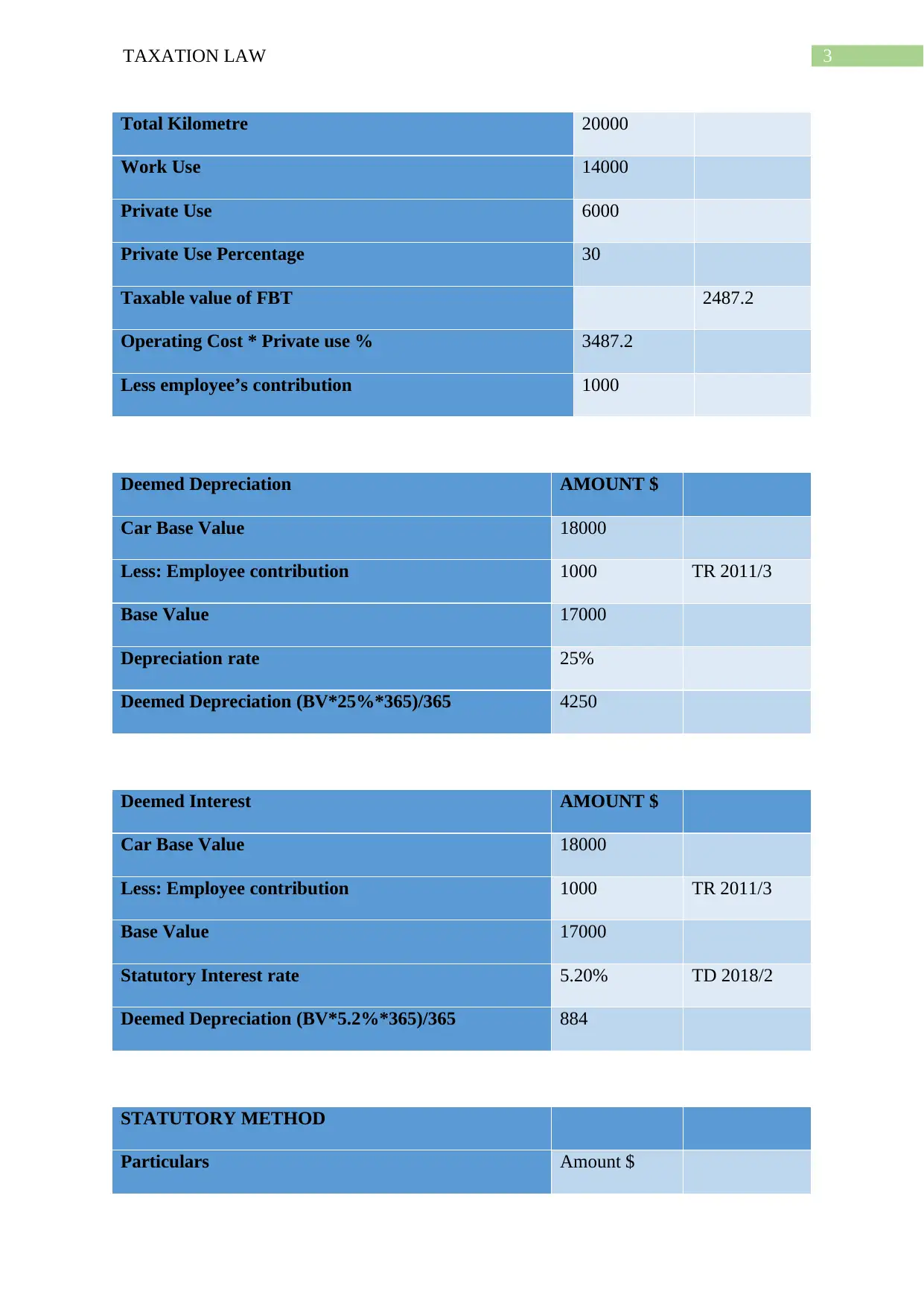
3TAXATION LAW
Total Kilometre 20000
Work Use 14000
Private Use 6000
Private Use Percentage 30
Taxable value of FBT 2487.2
Operating Cost * Private use % 3487.2
Less employee’s contribution 1000
Deemed Depreciation AMOUNT $
Car Base Value 18000
Less: Employee contribution 1000 TR 2011/3
Base Value 17000
Depreciation rate 25%
Deemed Depreciation (BV*25%*365)/365 4250
Deemed Interest AMOUNT $
Car Base Value 18000
Less: Employee contribution 1000 TR 2011/3
Base Value 17000
Statutory Interest rate 5.20% TD 2018/2
Deemed Depreciation (BV*5.2%*365)/365 884
STATUTORY METHOD
Particulars Amount $
Total Kilometre 20000
Work Use 14000
Private Use 6000
Private Use Percentage 30
Taxable value of FBT 2487.2
Operating Cost * Private use % 3487.2
Less employee’s contribution 1000
Deemed Depreciation AMOUNT $
Car Base Value 18000
Less: Employee contribution 1000 TR 2011/3
Base Value 17000
Depreciation rate 25%
Deemed Depreciation (BV*25%*365)/365 4250
Deemed Interest AMOUNT $
Car Base Value 18000
Less: Employee contribution 1000 TR 2011/3
Base Value 17000
Statutory Interest rate 5.20% TD 2018/2
Deemed Depreciation (BV*5.2%*365)/365 884
STATUTORY METHOD
Particulars Amount $
Paraphrase This Document
Need a fresh take? Get an instant paraphrase of this document with our AI Paraphraser
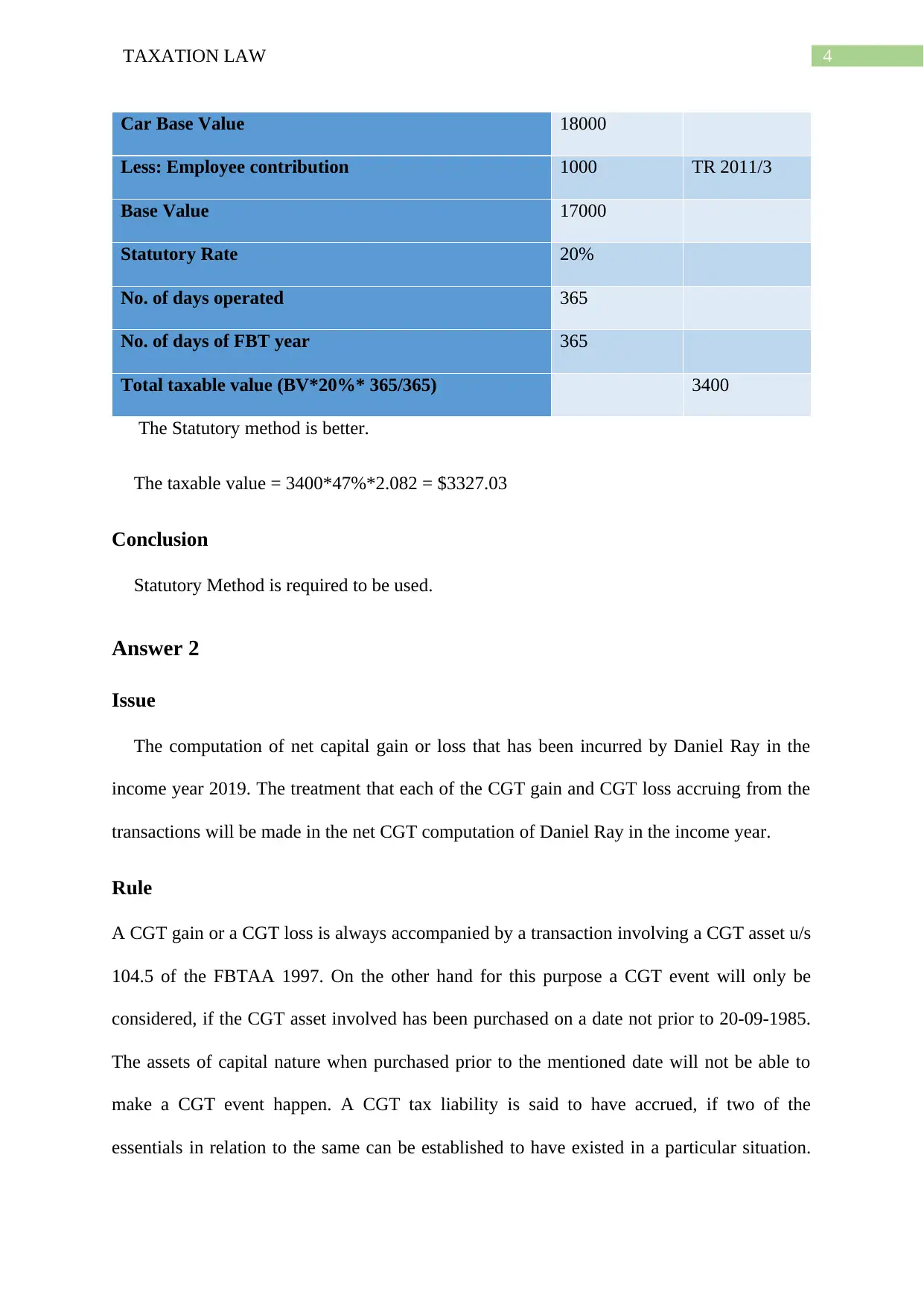
4TAXATION LAW
Car Base Value 18000
Less: Employee contribution 1000 TR 2011/3
Base Value 17000
Statutory Rate 20%
No. of days operated 365
No. of days of FBT year 365
Total taxable value (BV*20%* 365/365) 3400
The Statutory method is better.
The taxable value = 3400*47%*2.082 = $3327.03
Conclusion
Statutory Method is required to be used.
Answer 2
Issue
The computation of net capital gain or loss that has been incurred by Daniel Ray in the
income year 2019. The treatment that each of the CGT gain and CGT loss accruing from the
transactions will be made in the net CGT computation of Daniel Ray in the income year.
Rule
A CGT gain or a CGT loss is always accompanied by a transaction involving a CGT asset u/s
104.5 of the FBTAA 1997. On the other hand for this purpose a CGT event will only be
considered, if the CGT asset involved has been purchased on a date not prior to 20-09-1985.
The assets of capital nature when purchased prior to the mentioned date will not be able to
make a CGT event happen. A CGT tax liability is said to have accrued, if two of the
essentials in relation to the same can be established to have existed in a particular situation.
Car Base Value 18000
Less: Employee contribution 1000 TR 2011/3
Base Value 17000
Statutory Rate 20%
No. of days operated 365
No. of days of FBT year 365
Total taxable value (BV*20%* 365/365) 3400
The Statutory method is better.
The taxable value = 3400*47%*2.082 = $3327.03
Conclusion
Statutory Method is required to be used.
Answer 2
Issue
The computation of net capital gain or loss that has been incurred by Daniel Ray in the
income year 2019. The treatment that each of the CGT gain and CGT loss accruing from the
transactions will be made in the net CGT computation of Daniel Ray in the income year.
Rule
A CGT gain or a CGT loss is always accompanied by a transaction involving a CGT asset u/s
104.5 of the FBTAA 1997. On the other hand for this purpose a CGT event will only be
considered, if the CGT asset involved has been purchased on a date not prior to 20-09-1985.
The assets of capital nature when purchased prior to the mentioned date will not be able to
make a CGT event happen. A CGT tax liability is said to have accrued, if two of the
essentials in relation to the same can be established to have existed in a particular situation.
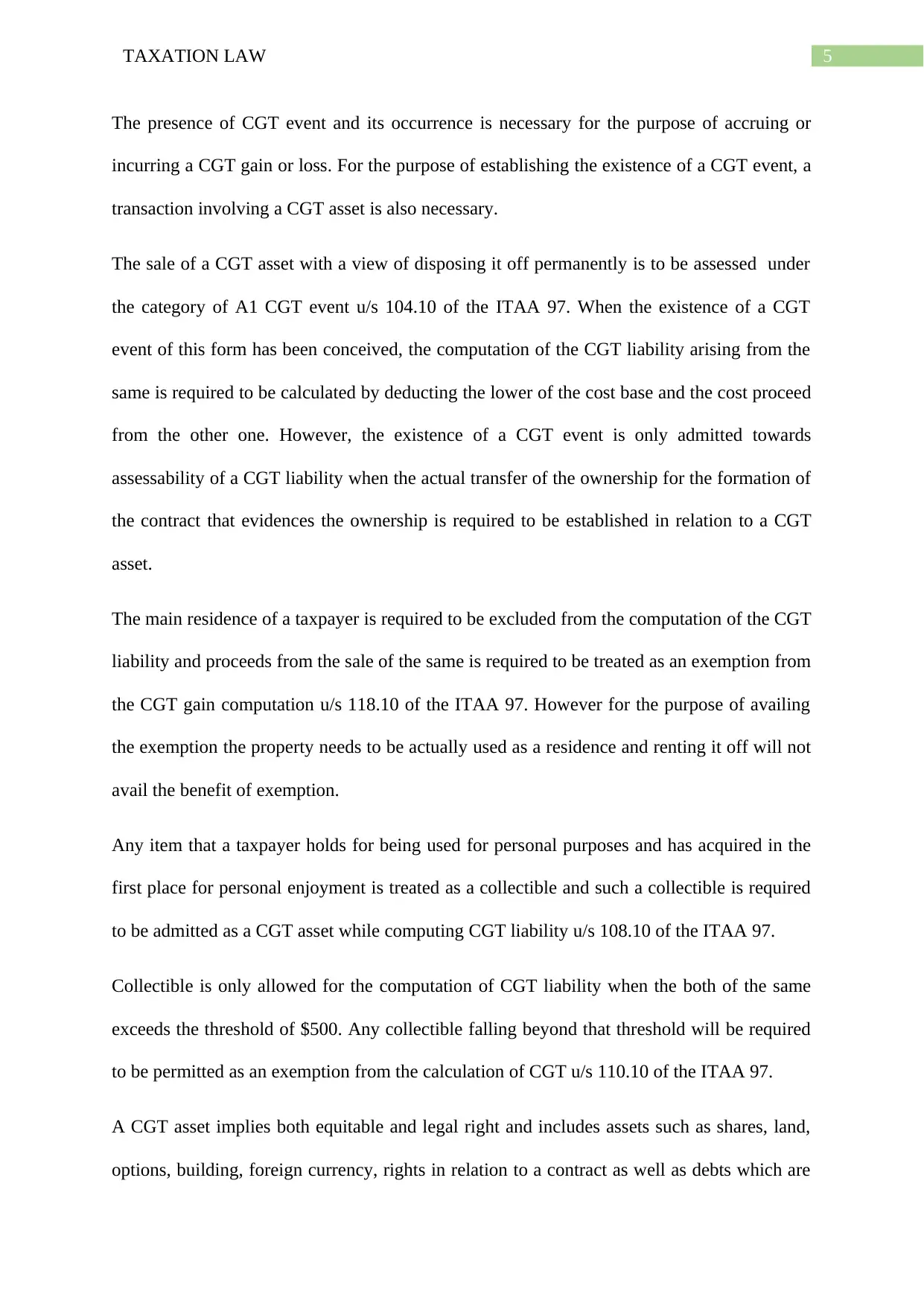
5TAXATION LAW
The presence of CGT event and its occurrence is necessary for the purpose of accruing or
incurring a CGT gain or loss. For the purpose of establishing the existence of a CGT event, a
transaction involving a CGT asset is also necessary.
The sale of a CGT asset with a view of disposing it off permanently is to be assessed under
the category of A1 CGT event u/s 104.10 of the ITAA 97. When the existence of a CGT
event of this form has been conceived, the computation of the CGT liability arising from the
same is required to be calculated by deducting the lower of the cost base and the cost proceed
from the other one. However, the existence of a CGT event is only admitted towards
assessability of a CGT liability when the actual transfer of the ownership for the formation of
the contract that evidences the ownership is required to be established in relation to a CGT
asset.
The main residence of a taxpayer is required to be excluded from the computation of the CGT
liability and proceeds from the sale of the same is required to be treated as an exemption from
the CGT gain computation u/s 118.10 of the ITAA 97. However for the purpose of availing
the exemption the property needs to be actually used as a residence and renting it off will not
avail the benefit of exemption.
Any item that a taxpayer holds for being used for personal purposes and has acquired in the
first place for personal enjoyment is treated as a collectible and such a collectible is required
to be admitted as a CGT asset while computing CGT liability u/s 108.10 of the ITAA 97.
Collectible is only allowed for the computation of CGT liability when the both of the same
exceeds the threshold of $500. Any collectible falling beyond that threshold will be required
to be permitted as an exemption from the calculation of CGT u/s 110.10 of the ITAA 97.
A CGT asset implies both equitable and legal right and includes assets such as shares, land,
options, building, foreign currency, rights in relation to a contract as well as debts which are
The presence of CGT event and its occurrence is necessary for the purpose of accruing or
incurring a CGT gain or loss. For the purpose of establishing the existence of a CGT event, a
transaction involving a CGT asset is also necessary.
The sale of a CGT asset with a view of disposing it off permanently is to be assessed under
the category of A1 CGT event u/s 104.10 of the ITAA 97. When the existence of a CGT
event of this form has been conceived, the computation of the CGT liability arising from the
same is required to be calculated by deducting the lower of the cost base and the cost proceed
from the other one. However, the existence of a CGT event is only admitted towards
assessability of a CGT liability when the actual transfer of the ownership for the formation of
the contract that evidences the ownership is required to be established in relation to a CGT
asset.
The main residence of a taxpayer is required to be excluded from the computation of the CGT
liability and proceeds from the sale of the same is required to be treated as an exemption from
the CGT gain computation u/s 118.10 of the ITAA 97. However for the purpose of availing
the exemption the property needs to be actually used as a residence and renting it off will not
avail the benefit of exemption.
Any item that a taxpayer holds for being used for personal purposes and has acquired in the
first place for personal enjoyment is treated as a collectible and such a collectible is required
to be admitted as a CGT asset while computing CGT liability u/s 108.10 of the ITAA 97.
Collectible is only allowed for the computation of CGT liability when the both of the same
exceeds the threshold of $500. Any collectible falling beyond that threshold will be required
to be permitted as an exemption from the calculation of CGT u/s 110.10 of the ITAA 97.
A CGT asset implies both equitable and legal right and includes assets such as shares, land,
options, building, foreign currency, rights in relation to a contract as well as debts which are
⊘ This is a preview!⊘
Do you want full access?
Subscribe today to unlock all pages.

Trusted by 1+ million students worldwide
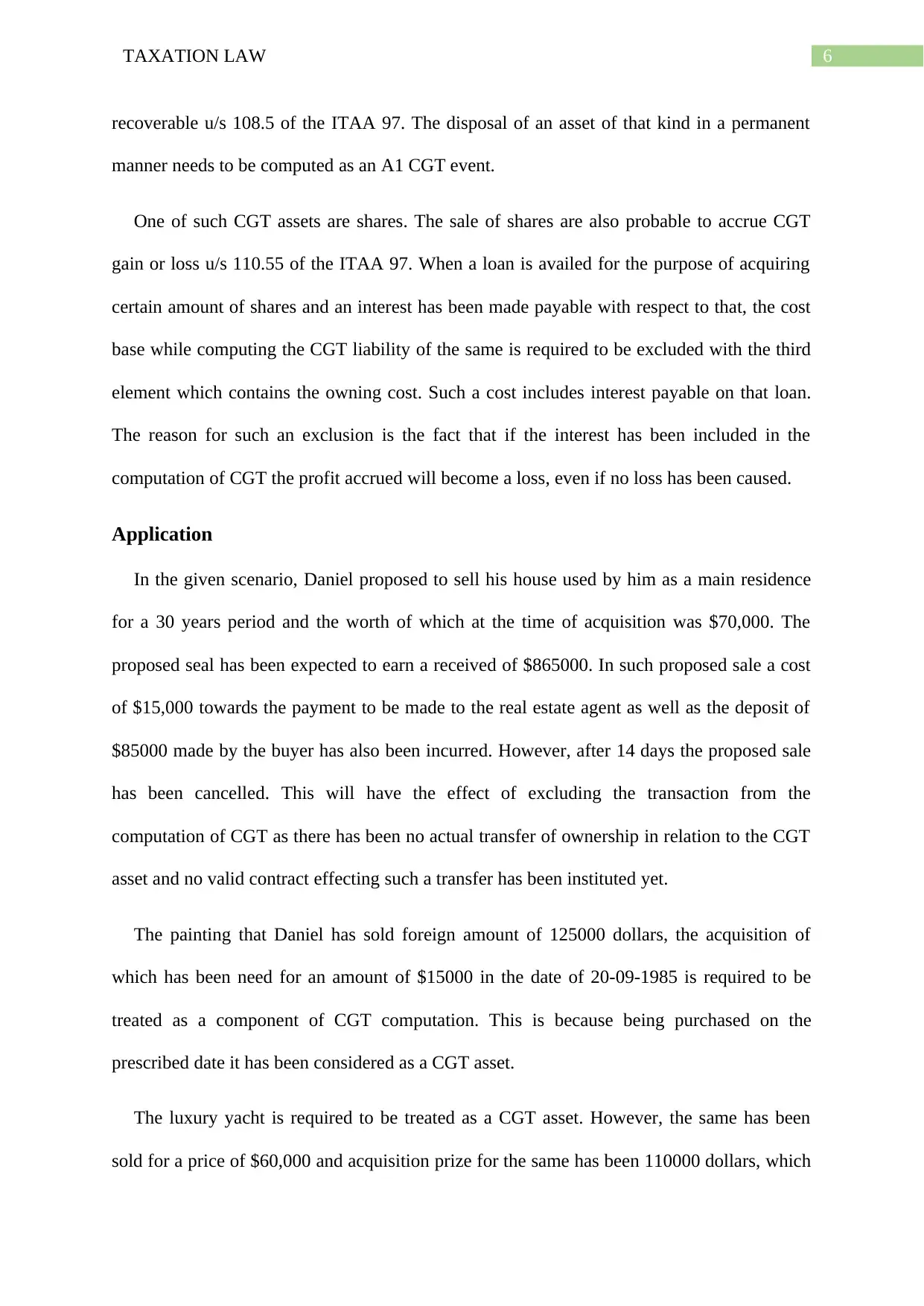
6TAXATION LAW
recoverable u/s 108.5 of the ITAA 97. The disposal of an asset of that kind in a permanent
manner needs to be computed as an A1 CGT event.
One of such CGT assets are shares. The sale of shares are also probable to accrue CGT
gain or loss u/s 110.55 of the ITAA 97. When a loan is availed for the purpose of acquiring
certain amount of shares and an interest has been made payable with respect to that, the cost
base while computing the CGT liability of the same is required to be excluded with the third
element which contains the owning cost. Such a cost includes interest payable on that loan.
The reason for such an exclusion is the fact that if the interest has been included in the
computation of CGT the profit accrued will become a loss, even if no loss has been caused.
Application
In the given scenario, Daniel proposed to sell his house used by him as a main residence
for a 30 years period and the worth of which at the time of acquisition was $70,000. The
proposed seal has been expected to earn a received of $865000. In such proposed sale a cost
of $15,000 towards the payment to be made to the real estate agent as well as the deposit of
$85000 made by the buyer has also been incurred. However, after 14 days the proposed sale
has been cancelled. This will have the effect of excluding the transaction from the
computation of CGT as there has been no actual transfer of ownership in relation to the CGT
asset and no valid contract effecting such a transfer has been instituted yet.
The painting that Daniel has sold foreign amount of 125000 dollars, the acquisition of
which has been need for an amount of $15000 in the date of 20-09-1985 is required to be
treated as a component of CGT computation. This is because being purchased on the
prescribed date it has been considered as a CGT asset.
The luxury yacht is required to be treated as a CGT asset. However, the same has been
sold for a price of $60,000 and acquisition prize for the same has been 110000 dollars, which
recoverable u/s 108.5 of the ITAA 97. The disposal of an asset of that kind in a permanent
manner needs to be computed as an A1 CGT event.
One of such CGT assets are shares. The sale of shares are also probable to accrue CGT
gain or loss u/s 110.55 of the ITAA 97. When a loan is availed for the purpose of acquiring
certain amount of shares and an interest has been made payable with respect to that, the cost
base while computing the CGT liability of the same is required to be excluded with the third
element which contains the owning cost. Such a cost includes interest payable on that loan.
The reason for such an exclusion is the fact that if the interest has been included in the
computation of CGT the profit accrued will become a loss, even if no loss has been caused.
Application
In the given scenario, Daniel proposed to sell his house used by him as a main residence
for a 30 years period and the worth of which at the time of acquisition was $70,000. The
proposed seal has been expected to earn a received of $865000. In such proposed sale a cost
of $15,000 towards the payment to be made to the real estate agent as well as the deposit of
$85000 made by the buyer has also been incurred. However, after 14 days the proposed sale
has been cancelled. This will have the effect of excluding the transaction from the
computation of CGT as there has been no actual transfer of ownership in relation to the CGT
asset and no valid contract effecting such a transfer has been instituted yet.
The painting that Daniel has sold foreign amount of 125000 dollars, the acquisition of
which has been need for an amount of $15000 in the date of 20-09-1985 is required to be
treated as a component of CGT computation. This is because being purchased on the
prescribed date it has been considered as a CGT asset.
The luxury yacht is required to be treated as a CGT asset. However, the same has been
sold for a price of $60,000 and acquisition prize for the same has been 110000 dollars, which
Paraphrase This Document
Need a fresh take? Get an instant paraphrase of this document with our AI Paraphraser
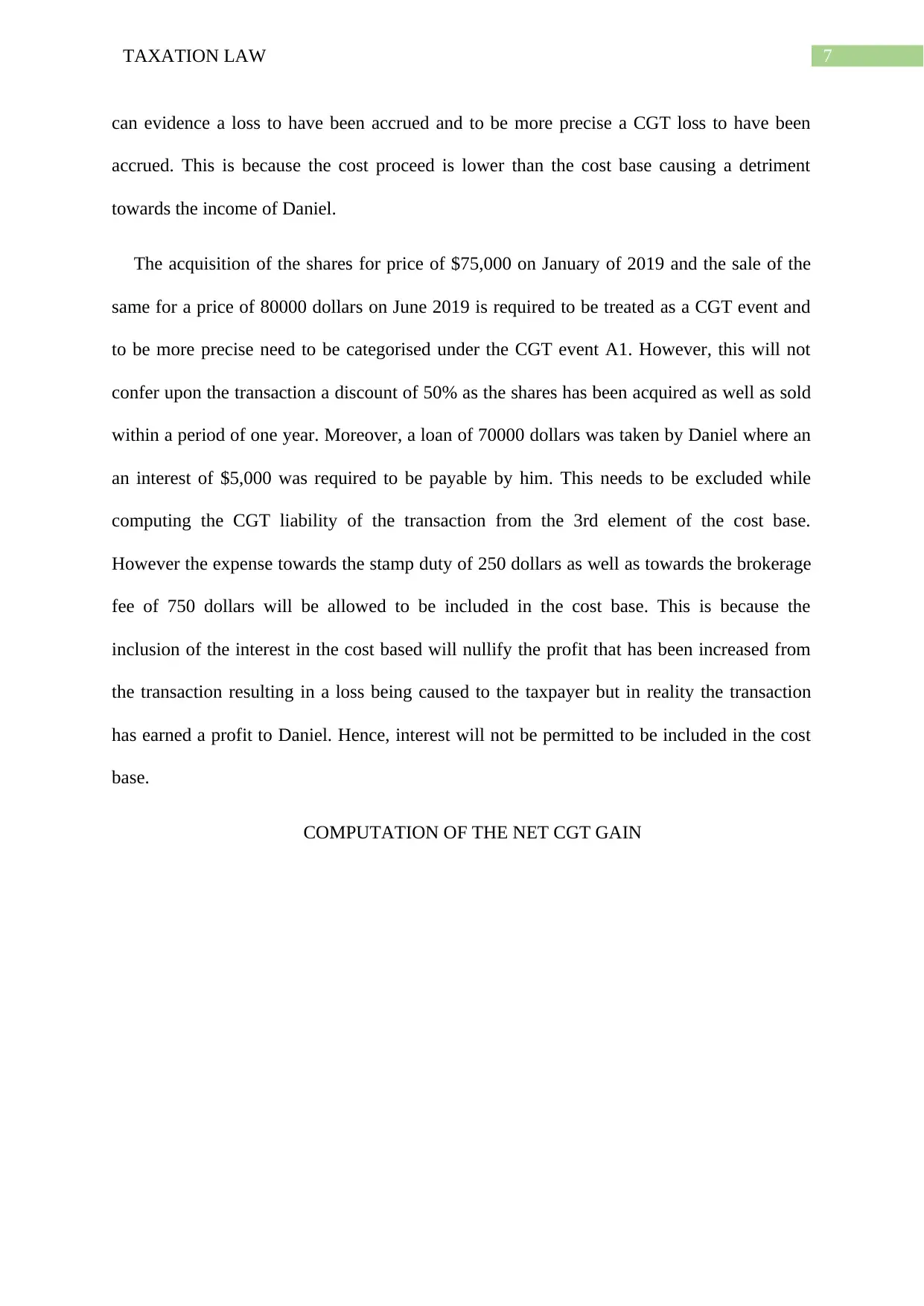
7TAXATION LAW
can evidence a loss to have been accrued and to be more precise a CGT loss to have been
accrued. This is because the cost proceed is lower than the cost base causing a detriment
towards the income of Daniel.
The acquisition of the shares for price of $75,000 on January of 2019 and the sale of the
same for a price of 80000 dollars on June 2019 is required to be treated as a CGT event and
to be more precise need to be categorised under the CGT event A1. However, this will not
confer upon the transaction a discount of 50% as the shares has been acquired as well as sold
within a period of one year. Moreover, a loan of 70000 dollars was taken by Daniel where an
an interest of $5,000 was required to be payable by him. This needs to be excluded while
computing the CGT liability of the transaction from the 3rd element of the cost base.
However the expense towards the stamp duty of 250 dollars as well as towards the brokerage
fee of 750 dollars will be allowed to be included in the cost base. This is because the
inclusion of the interest in the cost based will nullify the profit that has been increased from
the transaction resulting in a loss being caused to the taxpayer but in reality the transaction
has earned a profit to Daniel. Hence, interest will not be permitted to be included in the cost
base.
COMPUTATION OF THE NET CGT GAIN
can evidence a loss to have been accrued and to be more precise a CGT loss to have been
accrued. This is because the cost proceed is lower than the cost base causing a detriment
towards the income of Daniel.
The acquisition of the shares for price of $75,000 on January of 2019 and the sale of the
same for a price of 80000 dollars on June 2019 is required to be treated as a CGT event and
to be more precise need to be categorised under the CGT event A1. However, this will not
confer upon the transaction a discount of 50% as the shares has been acquired as well as sold
within a period of one year. Moreover, a loan of 70000 dollars was taken by Daniel where an
an interest of $5,000 was required to be payable by him. This needs to be excluded while
computing the CGT liability of the transaction from the 3rd element of the cost base.
However the expense towards the stamp duty of 250 dollars as well as towards the brokerage
fee of 750 dollars will be allowed to be included in the cost base. This is because the
inclusion of the interest in the cost based will nullify the profit that has been increased from
the transaction resulting in a loss being caused to the taxpayer but in reality the transaction
has earned a profit to Daniel. Hence, interest will not be permitted to be included in the cost
base.
COMPUTATION OF THE NET CGT GAIN
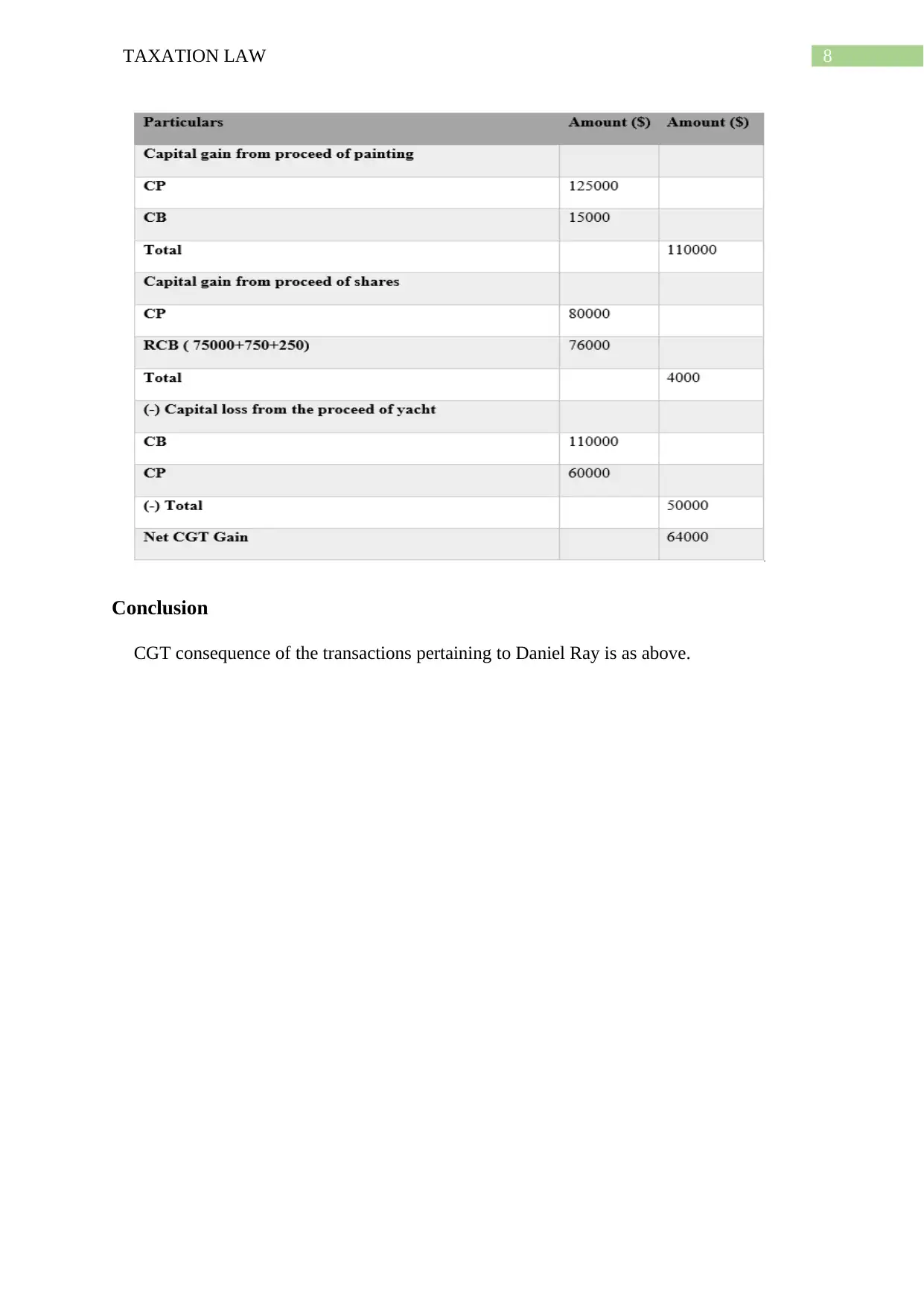
8TAXATION LAW
Conclusion
CGT consequence of the transactions pertaining to Daniel Ray is as above.
Conclusion
CGT consequence of the transactions pertaining to Daniel Ray is as above.
⊘ This is a preview!⊘
Do you want full access?
Subscribe today to unlock all pages.

Trusted by 1+ million students worldwide
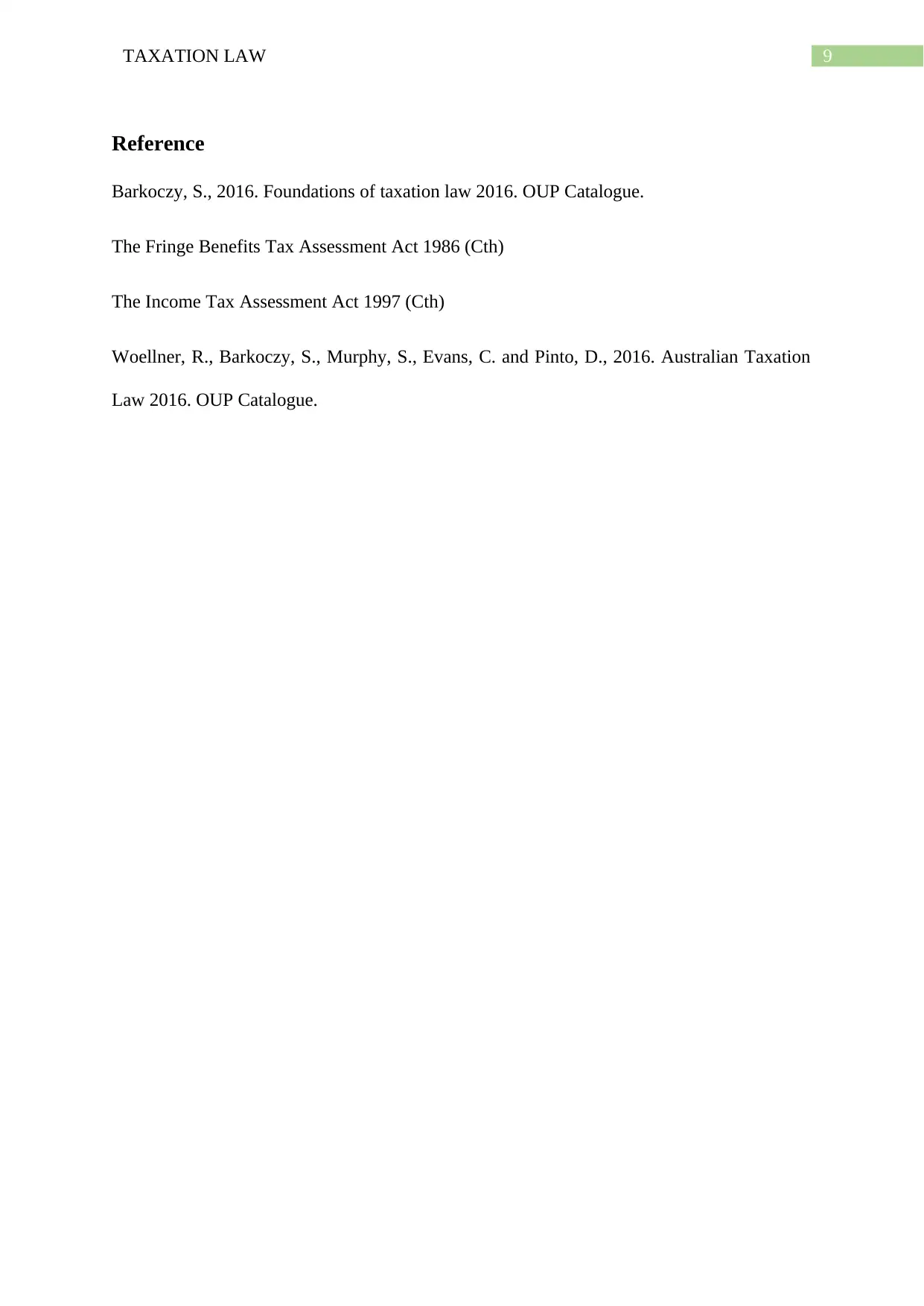
9TAXATION LAW
Reference
Barkoczy, S., 2016. Foundations of taxation law 2016. OUP Catalogue.
The Fringe Benefits Tax Assessment Act 1986 (Cth)
The Income Tax Assessment Act 1997 (Cth)
Woellner, R., Barkoczy, S., Murphy, S., Evans, C. and Pinto, D., 2016. Australian Taxation
Law 2016. OUP Catalogue.
Reference
Barkoczy, S., 2016. Foundations of taxation law 2016. OUP Catalogue.
The Fringe Benefits Tax Assessment Act 1986 (Cth)
The Income Tax Assessment Act 1997 (Cth)
Woellner, R., Barkoczy, S., Murphy, S., Evans, C. and Pinto, D., 2016. Australian Taxation
Law 2016. OUP Catalogue.
1 out of 10
Related Documents
Your All-in-One AI-Powered Toolkit for Academic Success.
+13062052269
info@desklib.com
Available 24*7 on WhatsApp / Email
![[object Object]](/_next/static/media/star-bottom.7253800d.svg)
Unlock your academic potential
Copyright © 2020–2025 A2Z Services. All Rights Reserved. Developed and managed by ZUCOL.




